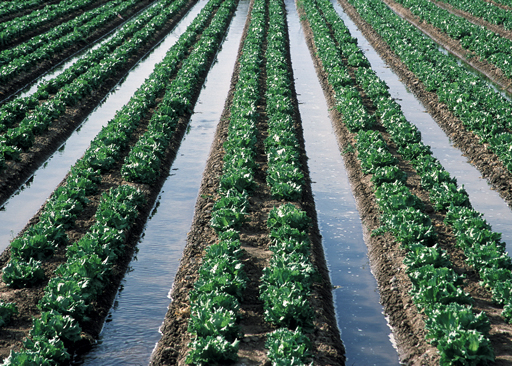11.3.2 Health protection measures
The critical parameter for assessing the suitability of using the effluent from waste stabilisation ponds for irrigation is microbiological analysis for the presence of pathogens. Treated effluent can be reused in crop irrigation if safe limits of faecal coliforms and intestinal parasites are achieved in the treatment process. The World Health Organization (2006) addresses this in Wastewater Use in Agriculture, Volume 2 of its Guidelines for the Safe Use of Wastewater, Excreta and Greywater. An important consideration is the type of crop that is being grown. If it meets specified standards, wastewater can be used to irrigate crops that are not eaten raw. This is called ‘restricted irrigation’ and includes non-food crops (such as cotton or oilseed), food crops that are processed before consumption (such as coffee or wheat), and crops that have to be cooked (such as rice or potatoes). For this type of crop, the WHO has specified that the level of faecal coliforms should not exceed 105 per 100 ml of treated effluent, and there should be no more than one intestinal nematode egg in 1 litre of treated effluent (WHO, 2006). (If children under the age of 15 are exposed to the treated effluent, for example by working or playing in fields irrigated with treated effluent, the limit for intestinal nematode eggs becomes stricter at one egg per 10 litres of treated effluent).
Another important consideration is the type of irrigation. If spray irrigation is used, there should be a buffer zone of 50–100 m between the irrigated fields and any nearby houses and roads, so that local people are not affected by airborne wastewater. In Ethiopia, flood irrigation or furrow irrigation is common; this is where farmers flow water down small trenches running through their crops (Figure 11.9). In this situation, the possibility of human contact with treated effluent is high.

In all situations, anyone who comes into contact with untreated or treated effluent should wear appropriate protective clothing, including gloves and boots. After working at the ponds, or after working on the irrigation of crops, people should wash themselves thoroughly. While the ponds may be designed for the production of water safe for irrigation, it is best to be safe and avoid all direct contact with the effluent.
11.3.1 Waste stabilisation ponds
